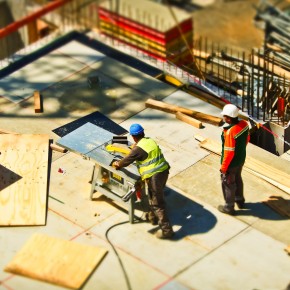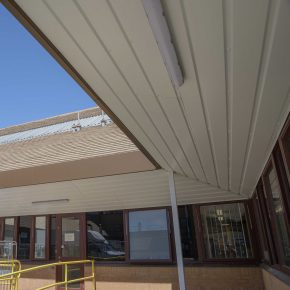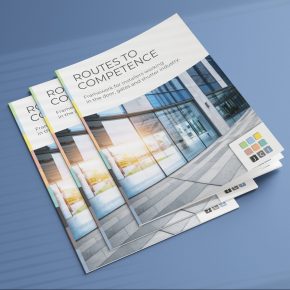
GUEST ARTICLE: Innovation in construction – utilising non-traditional materials
Leanne Thompson takes a look at how non-traditional materials can be used in construction for innovation.
Assisted by the good weather, the UK construction industry has recovered better than expected in 2018. This has lead to an increase in the amount of construction materials purchased. According to a report in The Guardian, this suggests that the previous downturn could have been due more to the grim weather of last winter than to any ongoing malaise in the construction industry.
This is good news for an industry which is looking towards innovation in materials, to help make its processes and projects more cost effective and sustainable; a move that can only make a healthy future more likely. According to the professionals at Provincial Rubber, “A wide range of sheeting materials that can resist the pressures of different environments can only be beneficial to the construction industry”. Developments do not stop there, many different non-traditional materials and processes are laying the foundations for the future of the construction industry.
3D printed concrete
Theoretically, you could see an iconic skyscraper being constructed by 3D printing concrete, at some point in time. In reality, this technique is more likely to be useful in smaller elements of construction, at least in the immediate future. That being said, some 3D printed structures already exist, such as the first footbridge to be made using the method which stands in the Castilla-La Mancha park, in Alcobendas, Madrid. The construction of this bridge shows that 3D printed concrete can be used to create unusually shaped structures that would be difficult to produce using other methods. This method of using concrete in construction also reduces wastage, as only the exact amount of concrete to be used is produced.
Concrete that heals itself
You may not think that the development of VELCRO has very much to do with the future of concrete, but there is a link. They are both centred on the idea of biomimics; materials that are created to mimic nature or by making use of features that exist in nature. VELCRO was inspired by the way plant burrs attached the fur of a dog. Self-healing concrete is inspired by the use of naturally occurring items, such as fungus that produces limestone. The items are added to the concrete. This addition helps the concrete to fix any fine cracks that appear, without the need for human intervention.
Photovoltaic glass
Building integrated photovoltaic (BIPV) technology is one of the biggest developments for the construction industry, when it comes to materials. The material can be used to turn an entire building into a solar panel as it can be used to create windows, roofs and facades. These areas of the building can be double glazed and insulated at the time of construction. The cost of using BIPV is not far in excess of using normal glass, when you take into account the fact that additional measures to clad, or provide shade for, a building are not necessary.
Wood that is super strong
Wood has been a popular construction material for centuries. It’s a readily available resource and it has a positive effect on the appearance of buildings. Some wood, such as oak, is known for its strength. The same cannot be said for all wood; or can it? The recently developed technique of creating super wood means that all wood can be strengthened and made resistant to pests and moisture. The technique involves treating the wood, using a similar method to the way wood pulp is produced. The wood is then compressed and treated with heat. This treated wood can be moulded into different shapes and becomes significantly harder than natural wood while also being scratch resistant.
Asphalt that protects the environment
Asphalt already had a positive effect on the environment, with the use of recycled rubber in its creation. Today, more work is being done on using other items in the mix; to help make the world a cleaner, and more sustainable, place. Items that could potentially be added include recycled plastic and cigarette butts. The latter of these additions may sound unlikely, but cigarette butts can apparently improve the safety of road surfaces. This idea of adding other items to asphalt seems set to be a main consideration in the future of construction.
Although the construction industry in the UK seems to be recovering from the dip that it experienced during last winter, it needs to remain competitive. It’s this consideration, together with the need to protect the environment, that is leading it to embrace the use of non-traditional materials and practices.
Latest news

26th April 2024
Alumasc Skyline and Rainwater package specified at Weston-super-Mare Hospital
A package of products from Alumasc Water Management Solutions (AWMS) has been used for the external refurbishment of the roofline at Weston General Hospital in Weston-Super-Mare.
Posted in Aluminium Products, Articles, Building Industry News, Building Products & Structures, Building Services, Building Systems, Case Studies, Cladding, Drainage Services, Drainage, Guttering, Soffits & Fascias, Fascias, Restoration & Refurbishment, Retrofit & Renovation, Roofs, Walls
26th April 2024
Hush Acoustics optimises fleet operations by securing FORS Gold accreditation
Hush Acoustics has invested in the safety and sustainability of its commercial vehicle fleet by achieving Gold status in the Fleet Operator Recognition Scheme (FORS).
Posted in Acoustics, Noise & Vibration Control, Articles, Building Industry News, Building Products & Structures, Building Regulations & Accreditations, Building Services, Ceilings, Facility Management & Building Services, Floors, Health & Safety, Insulation, Restoration & Refurbishment, Retrofit & Renovation, Site Preparation, Sustainability & Energy Efficiency, Walls, Waste Management & Recycling
26th April 2024
Safeguard Europe: Penetrating damp - how to diagnose the damage
As Safeguard gets ready to deliver another informative session of one of its most popular webinars, the company outlines some of the most common reasons for rain penetration through brickwork.
Posted in Articles, Bricks & Blocks, Building Industry Events, Building Industry News, Building Products & Structures, Building Services, Continuing Professional Development (CPD's), Damp & Waterproofing, Facility Management & Building Services, Information Technology, Posts, Render, Restoration & Refurbishment, Retrofit & Renovation, Seminars, Training, Walls
25th April 2024
ADSA: Competence Initiative Makes Progress
The Joint Competency Initiative (JCI), in which the Automatic Door Suppliers Association (ADSA) is involved, is finalising its first framework for installers within the door, gates and shutter industry.
Posted in Access Control & Door Entry Systems, Architectural Ironmongery, Articles, Building Associations & Institutes, Building Industry Events, Building Industry News, Building Products & Structures, Building Regulations & Accreditations, Building Services, Continuing Professional Development (CPD's), Doors, Facility Management & Building Services, Health & Safety, Innovations & New Products, Publications, Research & Materials Testing, Restoration & Refurbishment, Retrofit & Renovation, Security and Fire Protection, Site Preparation
 Sign up:
Sign up: 